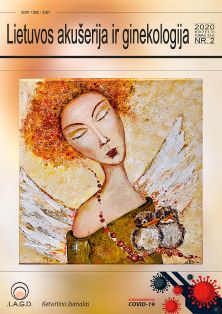PROGNOSIS ASSESSMENT OF URGENT CESAREAN SECTION AFTER INDUCED LABOUR
Abstract
Summary. The aim. To evaluate the prognostic reliability of the calculator predicting the probability of emergency caesarean in induced labours and to analyse which factors are associated with an increased risk of induced labour termination with caesarean section. Methods. Prospective study of 138 women admitted to the Obstetrics department of VUHSK for labour induction with prostaglandins in presence of an unripe cervix was performed. Maternal data were collected from medical records and the probability of caesarean section was calculated using a Web-based calculator. The mode of delivery was recorded postpartum. Results. The calculator reliably predicted the outcome of labour (OR–2.4, p<0.001). Delivery outcomes were statistical significantly correlated with parity, body mass index, gestational age, cervical dilation and Bishop score (p<0.05). Conclusions. Calculator for labour induction with unripe cervix satisfactorily predicted the risk of caesarean section in VUHSK. Maternal body mass index, parity, gestational age, cervical dilation, and Bishop
score were identified as significant risk factors for failed labour induction. This calculator can be useful in counselling of patients regarding the success of an induction and forming adequate expectations.

